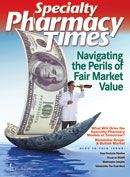Publication
Article
Specialty Pharmacy Times
Optimism and Opportunity
Author(s):
"An optimist sees the opportunity in every difficulty."
--Winston Churchill
This famous quote comes to mind when thinking about the current state of the specialty pharmacy industry. There is no doubt that society is reaping enormous benefits from the advancements in specialty pharmaceuticals that are improving treatment outcomes for many serious conditions such as multiple sclerosis, hepatitis C, cancer, and others.
At the same time, the specialty trend— the percentage increase in medication cost year-over-year—is growing at triple the pace of the overall pharmaceutical market. Not surprisingly, some are questioning how long the system can support this cost trend given the current health care environment and the huge pipeline of specialty medications under development.
The challenge becomes even more relevant to the specialty industry as we’re asked—and sometimes told— that we bear responsibility to Ensure Appropriate Use, Optimize Safety and Efficacy, and Preserve Affordability for the use of these innovative products.
While this is not a new challenge, the growth in the specialty trend, expensive drug costs, and the sheer number of new specialty products on the horizon, means that we must rely on methods that have worked in the past, even while we develop new and innovative approaches that will help patients and payers balance product benefit versus incurred cost. Some of the approaches highlighted below will be expanded for future topics—and focus areas of this new specialty pharmacy periodical.
Ensure Appropriate Use
Evidence-based Guidelines
Studies by the Institute of Medicine, RAND, and other organizations have highlighted the gap between scientifically based approaches to care and day-to-day practice by clinicians. Evidence-based guidelines are often developed to address this gap and represent the ongoing systematic review of the “science” around the diagnosis and treatment of specific conditions. These guidelines can be an effective tool in ensuring the appropriate, safe, and cost-effective use of specialty products. Specialty pharmacy is playing an expanded role in validating that specialty pharmaceuticals are being used within such guidelines.
Personalized Medicine and Pharmacogenomic Testing
This is the fastest growing and most exciting segment of our clinical arsenal for the use of specialty and other pharmaceutical products. Today, we have a handful of readily available pharmacogenomic tests that correlate an individual’s genetic makeup to how he or she may respond to a specific drug. For example, HER2 testing predicts the likely clinical response to Herceptin for breast cancer, and CYP2C9 measures an individual’s specific metabolism rate for certain drugs, such as warfarin, and assists with optimal dosing prior to writing the first prescription.
As the science presents us with more of these advanced tests, clinicians will be able to personally tailor pharmaceutical interventions while increasing the likelihood of a safe and positive clinical outcome.
Optimize Safety and Efficacy
Risk Evaluation and Mitigation Strategy (REMS)
REMS programs date back to the launch of Clozaril in the early 1990s, when the FDA required monitoring for agranulocytosis prior to dispensing another refill of the drug. Since then, the FDA has increasingly relied on REMS as a method to mitigate the risks and known adverse effects of an approved drug. A significant and important responsibility has been placed on the dispensing pharmacy and the pharmacist to ensure the proper administration of these critical safety programs. The number of REMS programs will substantially increase in the future and our roles as pharmacists and specialty pharmacies will be put to critical use.
Preserve Affordability
Biosimilars
Since the passing of the Hatch-Waxman Act in 1984, generics have provided an effective clinical alternative that yields substantial cost savings to patients and payers. The opportunity exists to replicate this dynamic with biologics, although with a heightened level of complexity that should not be overlooked. As biologics have a very complex manufacturing process that differs greatly from that of small molecules, there is ongoing debate over the criteria to demonstrate bioequivalence.
However, the recent passage of the Affordable Care Act (ACA) brings us one step closer to establishing this groundwork by creating a formal legislative pathway for approvals of biosimilars by the FDA. Even with this pathway in place, it is likely that many biosimilars will not be interchangeable and will require that a pharmacist receive a new prescription. Our role in helping patients and payers obtain the desired outcomes at the lowest cost will remain a top priority as we are asked to assist in driving adoption of these future therapeutic alternatives.
Specialty Formularies and Preferred Drugs
As therapeutic areas have become more crowded with specialty drugs, payers are increasingly able to evaluate products in a category and select a preferred product that yields the desired outcome at the lowest possible cost. This opportunity has led many managed care organizations to require the use of their preferred formulary product in order to obtain coverage. As this becomes even more prevalent, pharmacies will be increasingly responsible for intervening when the prescription is not written for the preferred alternative. We must maintain focus on our role within pharmacy of assisting patients and payers in managing the costs associated with drug therapy.
In the end, specialty pharmacy is at the center of some of the most exciting developments in health care. As pharmacists within the specialty pharmacy segment, we have established ourselves as a trusted source for delivering an increasingly complex level and quality of care. But our work has just begun, and just as with any segment of any industry, we must keep a keen eye on future needs and requirements to advance our value even further. While it will not be easy…I am an optimist.
About the Author
Mr. Golding is the Executive Vice President of Specialty Pharmacy Services at CVS Caremark.







